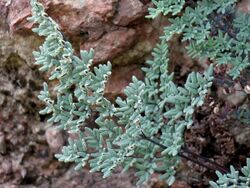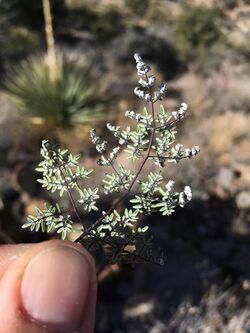Biology:Argyrochosma limitanea
| Argyrochosma limitanea | |
|---|---|

| |
| Fronds of southwestern false cloak fern growing from a rocky niche | |
| Scientific classification | |
| Kingdom: | Plantae |
| Clade: | Tracheophytes |
| Division: | Polypodiophyta |
| Class: | Polypodiopsida |
| Order: | Polypodiales |
| Family: | Pteridaceae |
| Genus: | Argyrochosma |
| Species: | A. limitanea
|
| Binomial name | |
| Argyrochosma limitanea (Maxon) Windham
| |
| Subspecies | |
| |
| Synonyms | |
| |
Argyrochosma limitanea, the southwestern false cloak fern, is a species of fern native to the southwestern United States and Sonora, Mexico. It grows on calcareous rocks, and has small, finely-divided leaves with a leathery texture, dark axes connecting the leaf segments, and a heavy coating of white powder on the undersurface. It reproduces apogamously; two subspecies are recognized, which may have originated independently through the hybridization of other taxa not yet discovered. First described as a species in 1919, it was transferred to the new genus Argyrochosma (the "false cloak ferns") in 1987, recognizing their distinctness from the "cloak ferns" (Notholaena sensu stricto).
Description
The rhizome is short and horizontal, with leaves closely spaced.[2] It bears thin[3] linear to lanceolate[4] brown[2][5] to reddish-brown[4] or chestnut-brown[3] scales, of a uniform color and with entire (toothless) margins.[3][4]
The leaves range from 5 to 30 centimeters (2.0 to 12 in) long.[2][5] The stipe (the stalk of the leaf, below the blade) is reddish-brown to black, rounded, without hairs or scales,[3][6][5] except that a few scales like those of the rhizome may be present at the very base.[3] It is 3 to 12 centimeters (1.2 to 4.7 in) long[4] and 0.75 to 2 millimeters (0.030 to 0.079 in) in diameter,[5] making up about one-half to one-third of the total length of the leaf.[2]
The leaf blades are 2.5 to 11 centimeters (0.98 to 4.3 in) long.[4] They vary from narrowly to broadly deltate (triangular) in shape,[7][5] and ranges from tripinnate (cut into pinnae, pinnules and pinnulets) to pentapinnate at the base, where it is most divided.[7][5] The rachis (leaf axis) is rounded or slightly flattened and hairless above, straight or slightly zig-zagging, [7][5] and dark in color, as are the axes of the leaf segments. The color continues into the base of the leaf segments, without a distinct joint.[7][5] From 6 to 12 pairs of pinnae are present, gradually narrowing at their tips and generally widest at their bases.[3] Leaf segments are numerous and closely spaced, small,[3] elliptic to ovate[4] or roundish to oblong in shape.[3] The leaf tissue has a leathery texture, obscuring the veins from the upper surface, and does not bear hairs or scales on either surface. The underside of the leaf has a thick covering of white farina (powder).[7][5][4] The leaves and axes curl upward when dry.[4]
In fertile leaf segments, the sporangia are close to the margin, borne along the further half of the secondary veins branching from the midrib of the segment. Each sporangium contains 32 spores. The leaf segments are curled under, often concealing the sporangia.[7][5] A. limitanea is an apogamous triploid, with a chromosome count of n = 2n = 81.[7][5]
Two subspecies are recognized: the typical A. limiteana subsp. limiteana, and A. limiteana subsp. mexicana. A. limiteana subsp. limiteana has broader blades (2 to 6 centimeters (0.8 to 2 in)),[4] broadly deltate-ovate in shape and more highly (4 to 5 times) divided at the base, with the lowest pinnae at least half the length of the entire leaf blade.[3][5][7] A. limiteana subsp. limiteana has narrower blades (1 to 2.5 centimeters (0.39 to 0.98 in)),[4] lanceolate to oblong in shape and less highly (3 to 4 times) divided at the base, with the lowest pinnae from one-third to one-quarter the length of the entire leaf blade.[3][5][7]
A. limitanea can be distinguished from A. incana and A. delicatula by its lack of a joint at the bases of leaf segments, with the dark color of the axes passing into the segment bases.[7] It is larger in all particulars than the closely related A. dealbata,[8] with darker leaf axes and thicker leaf tissue.[5]
Taxonomy
The species was first described in 1919 as Notholaena limitanea by William Ralph Maxon. The epithet limitanea presumably refers to its distribution along the border between the United States and Mexico; Maxon referred to it as the "Mexican Border plant" in distinguishing it from similar species.[9] He also described N. limitanea subsp. mexicana, with narrower leaves and some other characters distinguishing it from typical material.[10] Oliver Atkins Farwell lumped the latter into a broadly defined Notholaena nivea in 1931 as N. nivea var. mexicana.[11]
Both Edwin Copeland and Charles Alfred Weatherby suggested in the 1940s that a group of ferns related to Notholaena nivea might represent a distinct genus of its own.[12][13] Weatherby thought that, until that genus was described, the group might better be placed in Pellaea, rather than in Notholaena, but died in 1949 before he could circumscribe and publish it. Accordingly, in 1950, Conrad Vernon Morton transferred the species to Pellaea as P. limitanea, to provide a name for it in Thomas Henry Kearney's Flowering Plants and ferns of Arizona, and reduced the subspecies to a variety.[14] John T. Mickel, following Copeland's opinion that Notholaena was best lumped into a broadly defined Cheilanthes, transferred the species there as C. limitanea in 1979, also treating the subspecies as a variety.[15]
The recognition of the N. nivea group as a genus was finally addressed in 1987 by Michael D. Windham, who was carrying out phylogenetic studies of the cheilanthoids. He elevated Notholaena sect. Argyrochosma to become the genus Argyrochosma,[16] and transferred this species to that genus as A. limitanea.[17] He did not create a combination for N. limitanea subsp. mexicana at the time, but did so (at subspecific rank) in 1993.[18] In 2018, Maarten J. M. Christenhusz transferred the species to Hemionitis as H. limitanea, as part of a program to consolidate the cheilanthoid ferns into that genus.[19]
Phylogenetic studies have shown that A. limitanea is a sister species to A. dealbata, of the central and southern United States; these two species form a clade sister to another clade of several South American species.[20] The two subspecies are genetically distinct, and believed to be of independent allopolyploid origin, through the hybridization of sexual taxa not yet discovered. More than one cryptic allopolyploid taxon may be included within the present circumscription of A. limitanea subsp. limitanea.[21]
Distribution and habitat
Argyrochosma limitanea is known in the United States from San Bernardino County, California, east through Arizona, New Mexico, southern Utah, and Trans-Pecos Texas ,[22] and south into northern Mexico, extending as far southeast as Hidalgo.[7] A. limitanea subsp. limitanea ranges from California through Utah and into Mexico only in Sonora and Chihuahua. A. limitanea subsp. mexicana has a more easterly range, from Arizona through Texas and in Mexico from Chihuahua and Sinaloa east.[7][5]
Both subspecies grow on rocky slopes and cliffs, composed of either calcareous or volcanic rocks,[7][5][4] although A. limitanea subsp. mexicana shows a greater preference for calcareous substrates in Mexico.[7] A. limitanea subsp. limitanea is found at an altitude from 800 to 2,300 meters (2,600 to 7,500 ft), while A. limitanea subsp. mexicana, growing in the mountains, occurs from 1,500 to 2,500 meters (4,900 to 8,200 ft).[7][5]
Conservation
Under the NatureServe conservation status system, A. limitanea is ranked as apparently secure (G4), but it is considered imperiled in Texas.[1]
Notes and references
References
- ↑ 1.0 1.1 NatureServe 2020.
- ↑ 2.0 2.1 2.2 2.3 Mickel & Smith 2004, p. 67.
- ↑ 3.0 3.1 3.2 3.3 3.4 3.5 3.6 3.7 3.8 3.9 Tryon & Weatherby 1956, p. 86.
- ↑ 4.00 4.01 4.02 4.03 4.04 4.05 4.06 4.07 4.08 4.09 4.10 Lellinger 1985, p. 161.
- ↑ 5.00 5.01 5.02 5.03 5.04 5.05 5.06 5.07 5.08 5.09 5.10 5.11 5.12 5.13 5.14 5.15 5.16 Windham 1993.
- ↑ Mickel & Smith 2004, pp. 67–68.
- ↑ 7.00 7.01 7.02 7.03 7.04 7.05 7.06 7.07 7.08 7.09 7.10 7.11 7.12 7.13 7.14 Mickel & Smith 2004, p. 68.
- ↑ Maxon 1919, p. 73.
- ↑ Maxon 1919, p. 70.
- ↑ Maxon 1919, p. 72.
- ↑ Farwell 1931, p. 283.
- ↑ Morton 1950, pp. 249–250.
- ↑ Windham 1987, p. 37.
- ↑ Morton 1950, pp. 249–251.
- ↑ Mickel 1979, pp. 434–435.
- ↑ Windham 1987, p. 38.
- ↑ Windham 1987, p. 40.
- ↑ Windham 1993a, p. 32.
- ↑ Christenhusz, Fay & Byng 2018, p. 17.
- ↑ Sigel et al. 2011, pp. 558, 561.
- ↑ Sigel et al. 2011, p. 561.
- ↑ Kartesz 2014.
Works cited
- Christenhusz, Maarten J. M.; Fay, Michael F.; Byng, James W. (8 February 2018). Plant Gateway's the Global Flora: A practical flora to vascular plant species of the world. 4. ISBN 978-0-9929993-9-1.
- Farwell, Oliver Atkins (1931). "Fern Notes II. Ferns in the Herbarium of Parke, Davis & co". American Midland Naturalist 12 (8): 233–311. doi:10.2307/2420088.
- Kartesz, John T. (2014). "Argyrochosma". Biota of North America Program. http://bonap.net/NAPA/TaxonMaps/Genus/County/Argyrochosma.
- Lellinger, David B. (1985). A Field Manual of the Ferns & Fern-Allies of the United States & Canada. Washington, DC: Smithsonian Institution Press. ISBN 0874746035. https://archive.org/details/fieldmanualoffer00lell.
- Maxon, William R. (1919). "Notes on American Ferns—XIV". American Fern Journal 9 (3): 67–73. doi:10.2307/1544329. https://www.biodiversitylibrary.org/page/30817354.
- Mickel, John T. (1979). "The fern genus Cheilanthes in the continental United States". Phytologia 41 (6): 431–437. doi:10.5962/bhl.part.20791. https://www.biodiversitylibrary.org/page/13298664.
- Mickel, John T.; Smith, Alan R. (2004). The Pteridophytes of Mexico. Memoirs of the New York Botanical Garden. 88. Bronx, New York: New York Botanical Garden. ISBN 978-0-89327-488-7.
- Morton, C. V. (1950). "Notes on the ferns of the eastern United States". American Fern Journal 40 (4): 241–252. doi:10.2307/1545864. https://www.biodiversitylibrary.org/page/32415554.
- "Argyrochosma limitanea". NatureServe. November 10, 2020. http://explorer.natureserve.org/servlet/NatureServe?searchName=Argyrochosma+limitanea.
- Sigel, Erin M.; Windham, Michael D.; Huiet, Layne; Yatskievych, George; Pryer, Kathleen M. (2011). "Species Relationships and Farina Evolution in the Cheilanthoid Fern Genus Argyrochosma (Pteridaceae)". Systematic Botany 36 (3): 554–564. doi:10.1600/036364411X583547.
- Tryon, Rolla M.; Weatherby, Una F. (1956). "A revision of the American species of Notholaena". Contributions from the Gray Herbarium of Harvard University (179): 1–106. doi:10.5962/p.336378. https://www.biodiversitylibrary.org/page/39561936.
- Windham, Michael D. (1987). "Argyrochosma, a new genus of cheilanthoid ferns". American Fern Journal 77 (2): 37–41. doi:10.2307/1547438. https://biodiversitylibrary.org/page/32225984.
- Windham, Michael D. (1993). "Argyrochosma limitanea". in Flora of North America Editorial Committee. Flora of North America North of Mexico. 2: Pteridophytes and Gymnosperms. New York and Oxford: Oxford University Press. http://efloras.org/florataxon.aspx?flora_id=1&taxon_id=233500152.
- Windham, Michael D. (1993a). "New taxa and nomenclatural changes in the North American fern flora". Contributions from the University of Michigan Herbarium 19: 31–62. https://www.biodiversitylibrary.org/page/12874434.
External links
- Holotype of the species at JSTOR Plant Science.
- Isotype of Argyrochosma limitanea subsp. mexicana at JSTOR Plant Science.
- Jepson Manual eFlora (TJM2) treatment of Argyrochosma limitanea subsp. limitanea
- UC Photos gallery — Argyrochosma limitanea
Wikidata ☰ Q15598168 entry
 |



